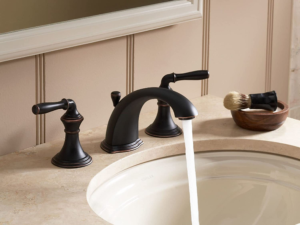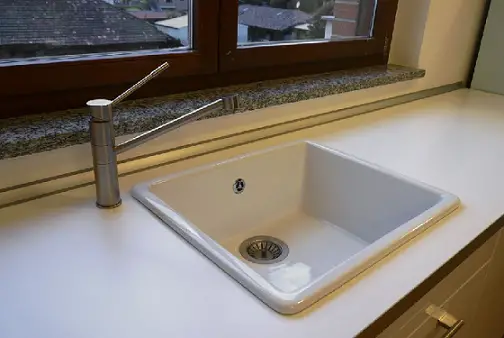It’s easier to install faucets today; in fact, some faucets can be installed completely from the top, so you do not have to go under your sink. However, before getting your hands dirty, you will need to make some crucial decisions, including whether to put your faucet on the side of the sink.
While it is not the norm as faucets are typically mounted at the centre between the sink and wall back, you can put a faucet on the side of the sink.
You may decide to hire a plumber to get the job done, but you should know what a side-mount means. In this post will compare between a centre and side-mounting and even help you pick the right faucet to help you make the right choice.
Can You Put Faucet On Side of Sink?
Before deciding to put your faucet on the side let us compare between side mounting and centre mounting a faucet. This way you can make a more informed choice between the two.
Centre-Mounting
This versatile design is the most common installation type seen in most bathroom sinks. This style entails mounting the handles and the faucet spout together to form a single unit.
Most centres faucets offer separate controls for cold and hot water, allowing you to mix them giving you the ideal temperature every time you use the sink. In addition, it is easy to operate this faucet because it has two handles.
You can use it on sinks that have three holes, with 6” and 4” faucet centres. Attaching the faucet at the sink’s back offers a better drain and faucet spray alignment, which prevents unnecessary overflow or spray.
This type of placement also keeps the sides of your sink free, giving you the ultimate counter space. In addition, it streamlines the under-the-sink plumbing, providing additional storage space.
Additionally, installing a faucet at the centre is easier because you only have to deal with a single piece rather than multiple parts. However, they are less adaptable, hard to clean, and not the most ideal if you want a fancy-looking bathroom.
Go for centre-mounting if you have a pedestal and drop-in sinks.
Side-Mounting

Side-mount faucets are mainly seen in accessible designs and shallow or small spaces. Both cases make it easy to reach the tap since it’s near the counter’s front.
Ease of use is a compelling idea to use this faucet, and it is also simpler and faster to clean up. This placement permits a shallower counter and gives you more counter space to utilize for other things.
See also How to prevent water behind the sink
Reasons to Put Faucet on Side of Sink
You are better off side-mounting your faucet in the following situations. However, ensure you have the right sink for this placement.
1. When Using A Vessel Sink
Consider side-mounting if you have a vessel sink, but that will depend on your bathroom or kitchen’s design, faucet style, and the vessel itself.
2. Limited Space
Side-mounting will also suit you if the region between the backsplash and the sink cannot accommodate the faucet because it’s small. Alternatively, there might be something underneath the sink inhibiting centre-mounting.
3.Accessibility
Placing your faucet on the side will allow you to swivel it freely, provided it’s that kind of faucet.
4. The Décor Calls For A Side Faucet Placement
Your bathroom or kitchen’s design could be better complimented by side-mounting the faucet instead of centring it. You will have to assess the situation critically to determine if that’s the case.
A simple alteration can change your bathroom or kitchen’s aesthetics, so don’t overlook it.
See also how to keep bathroom counter dry
How To Put Faucet On The Side Of The Sink
Upgrading your sink faucet is an exciting time, but one that comes with crucial decision-making. It is an affordable way to modernize your workspace without spending a lot of your time; you don’t even have to get a new sink.
While you can DIY the project efficiently, ensure you plan for the work properly. Here’s what you’ll need to do to install a new faucet on the side of your sink.
1. Choose The Right Faucet
Before shopping, you will need to find out the exact hardware currently in your sink. This is because choosing a faucet that will fit into the hole configuration of your sink will make your work easier.
Look under your sink to determine the position of the connections and holes, then match them with the new faucet.
2. Turn Off The Water Valves
Before replacing the faucet, turn off the valve underneath the sink to stop the water supply. You can also shut it off from the meter if you can’t find the main valve.
3. Detach The Old Faucet
You must remove the old faucet before fixing it in the new one. Do so by unscrewing the nuts holding the tap in place with an adjustable wrench (you’ll find them under the sink).
You may need a light source to illuminate the area as it will likely be dark. Moreover, this space might be narrow, making the task a bit challenging.
4. Drill New Holes If Necessary
If the new faucet requires increasing or changing holes, drill new ones on your sink to ensure the faucet will be installed successfully. Case the area beforehand using painter’s tape, mark each hole’s center, then create a pilot hole with a hole saw drill bit.
Read also What is the white slime in sink drain
5. Put In The Escutcheon Plate
Cover the additional holes with an escutcheon plate if you switch from a three-hole faucet to a one-hole tap. Make sure you adhere to the instructions from the manufacturer to ensure you create a watertight plate.
6. Install The New Faucet
Insert the faucet line down the hole, adjusting it properly to make sure it’s positioned well. Secure the faucet, nuts, and washers under the counter using the hardware that came with the tap.
Confirm that the faucet is in the right position from above before tightening the brackets and nuts.
7. Attach The Water Supply Lines
If your faucet doesn’t come with attached supply lines tubing, labeled cold or hot, you’ll have to connect them. Use Teflon tape to encase the threads anticlockwise the join each with the cold and hot supply valves underneath the sink.
8. Turn On The Supply Line
Switch on the supply line slowly as you check for any leaks. Also, make adjustments, such as tightening the connections before testing your installation again.
See also Causes of water pooling on bathroom counter
Conclusion
Putting the faucet on the side of the sink boils down to practicality and preference. You might purely prefer having it there, or you don’t have enough space for centre-mounting.
Regardless of your reason, make sure you pick a faucet that will go well with your sink and also complement your bathroom or kitchen décor.
Read also Can p trap be higher than drain pipe

